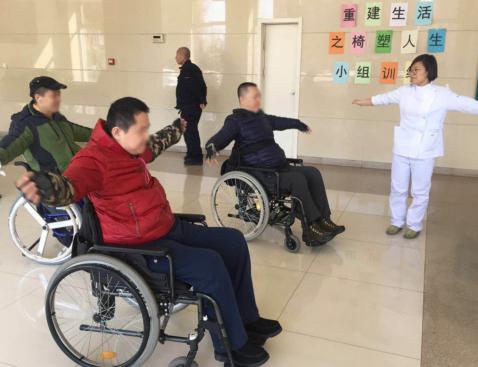基于“重建生活为本”的作业治疗小组活动设计与实践
刘亚琼 贺鹭 李丹 刘军军 王晓艳 谭丹丹

【摘要】脊髓損伤(SCI)是常见的创伤性疾病,常发生在30岁以下的人群[1]。随着社会的发展,由于交通事故和高处坠落导致的颈椎损伤患者越来越多。国际功能、残疾和健康分类(ICF)提出除了身体功能方面的障碍,更多关注于“活动”与“参与”,高位截瘫病人康复需要更多的社会参与。而目前对于颈椎脊髓损伤的患者更多地关注残存肌力的训练,关节活动度的训练,预防并发症的训练,而对患者功能和能力、活动和参与、生活意志和生活方式的关注度比较少。作业治疗领域提出“生活重整”的概念[2],协助患者接受及适应这些长期症状或功能障碍,充分利用自己现有的能力及环境资源,学习适应策略和技巧,重建生活的信心,开展有益于提高患者的活动和参与的治疗方法[3-4]。
梁国辉[5]曾提出生活重整的概念与实践,并推广“重建生活为本”的作业治疗模式。在追求最大程度功能恢复的基础上,增添及强化与生活相关的康复治疗元素,协助患者利用现有的运动、认知和交流功能,学习多领域代偿生活技能,调节家庭、朋友和社会角色,建立新的生活方式,最终达至幸福生活[6]。从而重建患者的生活意志、生活能力、生活方式,称为“三元合一”。
通过参与香港职业学院的“重建生活为本的作业治疗模式”培训班,结合我科患者情况,设计并开展一期颈椎损伤患者“重建生活为本”的轮椅小组训练,以“椅塑人生”为主题,帮助提高患者的轮椅操控能力的同时,重建患者的生活意志,增加患者之间的交流,提高患者活动和参与能力。以下为本次作业小组活动的设计与实践。
【关键词】作业治疗;重建生活;颈椎脊髓损伤;轮椅训练
Design and practice of occupational therapy group based on "rebuiding of life" a wheelchair training group for patients with cervical spinal cord injury
Abstract Spinal cord injury(SCI)is a common traumatic disease, which is often occurring in people under 30 years old. With the development of society, there are more and more patients with cervical spinal cord injury due to traffic accidents and high falls. International Classification of function, disability and health(ICF)proposes in addition to the disorders of the body function,we should pay more attention to the "activity" and "participation", paraplegic patients rehabilitation needs more social participation. And at present we pay more attention to the residual muscle strength training, ROM training, prevention of the complications training, But less the training of function and ability, activity and participation, life will and life way in patients with cervical spinal cord injury (sci). Occupational therapy puts forward the concept of "life rebuiding",which is to help patients to accept and adapt to these symptoms or disorders for a long time, make full use of their existing capacity and environmental resources, learn adaptation strategies and skills, rebuild the confidence of life, take the treatment to improve the patients activities and participation.
Liang guohui has put forward the concept and practice of life rebuiding, and promote the "reconstruction of life as the present" occupational therapy mode. On the pursuit of the greatest degree of functional recovery ,thats the basis, and then increase and strengthen rehabilitation elements associated with life, assist patients using existing motion, cognition and communication functions, learn multidisciplinary compensatory life skills, adjust the family, friends and social role, establish a new way of life, eventually to a happy life. To rebuilt the patients life will, life ability, the way of life, thats called "the unity of the three elements".
By participating the training course called "rebuild their lives for this occupational thearpy model" in the Hong Kong occupational technique college , combines the condition of patients in my rehabilitation medicine department , to design and carry out the first phase of wheelchair group training for the cervical spine injury patients, called "rebuild their lives for this" , with the theme "chair plastic life" ,we want to improve the wheelchair control ability of patients, meanwhile to reconstruc the life will, increase the communication between patients, improve patients activity and participation ability. The following is the design and practice of this training.
Keywords Occupational therapy; Rebuilding life; Cervical spinal cord injury; Wheelchair training;
1作业活动设计原则
1.1活动原则:①围绕轮椅操控为训练主题;②根据颈椎脊髓损伤患者的功能情况,设计轮椅使用技巧与实践,以利于提高患者功能轮椅操控的能力;③合理设计轮椅操控难易程度,以利于提高患者获得成功的心理;④在适当的时候给于指导和帮助,每次活动60分钟。
1.2对象:颈椎損伤患者3~5名,生命体征平稳。
2轮椅训练的作业治疗小组
2.1目的:提高颈椎脊髓损伤患者轮椅的操控能力,增强生活的动力和意志,提高患者融入周边环境并参与小区周边生活的能力。
2.2活动内容:选取本科室颈椎脊髓损伤患者3~5名,作业治疗师2名,医生和护士各1名。患者临床生命体征平稳,患者及家属配合。以“重建生活为本之椅塑人生”为主题,开展轮椅训练小组活动。
2.2.1动机性访谈:动机访谈法(MI)是一种强调以患者为中心,通过帮助患者探索并解决内心矛盾而诱发其行为改变的指导性行为改变方法[7]。通过该方法的访谈,提升患者内在动力并使其行为改变。访谈的内容从患者对目前出行障碍的思考开始,引导患者对自由的向往,指出通过参与活动可以提高轮椅操控技能的同时,还增加了和病友之间的交流以及社区生活的参与。
2.2.2轮椅训练介绍:轮椅训练是脊髓损伤(SCI)患者一项重要的康复训练内容。通过轮椅训练,能够强化上肢、躯干肌力,提高坐位平衡和运动功能,最重要的是可以大大提高患者操纵轮椅的技术水平,提高功能独立性和日常生活活动能力(ADL),对于他们重返社会起着非常重要的作用[8]。
2.2.3轮椅操作:规范化的轮椅技能训练能够显著提升截瘫患者的ADL及轮椅操作技能,提高截瘫患者的康复治疗的疗效、患者的生存质量,有利于患者重返家庭及社会生活[9]。根据颈椎脊髓损伤的患者设计三项实用性训练内容包括:①直行训练:包括直行和倒退,指导患者进行十米直行训练,并记录前进和倒退的时间;②转弯训练:指导患者通过一侧手臂固定,另一侧手臂划动轮椅,分别向左向右转弯训练;③通过障碍:连续转弯通过间距不等的障碍物。
2.2.4轮椅减压:脊髓损伤的并发症之一就是压疮,长时间的轮椅坐位很容易引起压疮,因此正确的定时轮椅减压对于预防压疮至关重要。本次轮椅训练为颈椎脊髓损伤的患者,双上肢的力量比较弱,因此指导患者通过单侧减压的方式进行:一侧上肢置于轮椅扶手后,身体向一侧倾斜,使臀部离开椅面,然后换另一侧上肢置于扶手后,身体倾斜,使另一侧臀部抬起。每30分钟进行一次,每侧臀部抬起维持3~5秒;在陪护人员保护下,也可选择身体向前靠30~60秒进行臀部减压;同时也可使用轮椅垫等辅助用具,减轻臀部皮肤的压力。
2.2.5轮椅实践:①轮椅操:选取约十分钟的颈椎脊髓损伤患者双上肢的轮椅操训练作为每次活动的热身及整理活动;②医院住院楼内实践:进行建筑内轮椅操控练习,综合进行轮椅操控以及轮椅上作业活动,包括轮椅直行、转弯、通过障碍,轮椅上作业活动如穿脱衣、戴帽、取物、开矿泉水瓶、带万能袖带书写等;③医院内户外轮椅综合操控实践:设定直行、转弯、通过障碍、5°小斜坡上下,长距离轮椅训练等多个综合练习;④轮椅购物:选择距离医院约1千米的综合超市,设定购物金额及购物清单,每个患者通过轮椅滑行独立购买5种物品且不超过设定金额。选购过程中,进行轮椅操控、够取货物、寻求周边帮助等多个涉及活动与参与方面的训练。
2.2.6总结访谈:轮椅训练及实践活动之后,组织患者进行总结访谈。访谈内容包括:①本次轮椅训练的收获;②是否突破之前的自我;③轮椅操控的技能提高后的应用,以及如何改善未来生活的想法。通过“椅塑人生”———轮椅小组作业活动的设计与实践,从患者的生活意志、生活能力、生活方式三个方面进行重建,帮助患者重新进入角色,调整心态,重建生活。


